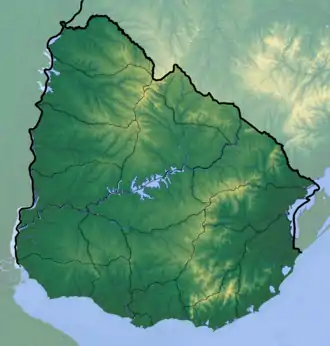| Raigón Formation | |
|---|---|
| Stratigraphic range: Huayquerian-Montehermosan ~ | |
| Type | Geological formation |
| Underlies | Libertad Formation |
| Overlies | Fray Bentos Formation |
| Lithology | |
| Primary | siltstone |
| Location | |
| Country | |
| Type section | |
| Named for | Raigón, Uruguay |
 Raigón Formation, Uruguay | |
The Raigón Formation is a Huayquerian-Montehermosan geologic formation in Uruguay.[1]
Overview
In 1966, Uruguayan geologists Héctor Goso and Jorge Bossi defined the Raigón Formation, which they subdivided into the San José Member (the same as Francis and Mones' San José Formation) below and the San Bautista Member above.[2] In 1988, Álvaro Mones identified Lower Pleistocene levels in the San José Member.[3] In 2002, American geologist H. McDonald and Uruguayan paleontologist Daniel Perea suggested the formation may represent a wide timespan from the Montehermosan all the way to the Ensenadan.[4]
A notable finding was J. monesi, recovered in situ from a boulder originating in the San José Member. The boulder is made up of siltstone, claystone, and medium-grained and medium-to-conglomeratic psammite (a type of sandstone) intercalated with siltstone.[5]
Fossil content
The following fossils have been reported from the formation:
See also
References
- ↑ Raigón Formation at Fossilworks.org
- ↑ Goso, H.; Bossi, J. (1966). "Cenozoico". In Bossi, J. (ed.). Geología del Uruguay [Geology of Uruguay] (in Spanish). Universidad de la República, Montevideo. pp. 259–301.
- ↑ Mones, A. (1988). "Notas paleontológicas uruguayas. IV. Nuevos registros de mamíferos fósiles de la Formación San José (Plioceno–Plesitoceno inferior?) (Mammalia: Xenarthra; Artiodactyla; Rodentia)". Comunicaciones Paleontologicas Museo Nacional de Historia Natural de Montevideo. 20: 255–277.
- ↑ Mcdonald, H. G.; Perea, D. (2002). "The large scelidothere Catonyx tarijensis (Xenarthra, Mylodontidae) from the Pleistocene of Uruguay". Journal of Vertebrate Paleontology. 22 (3): 677–683. doi:10.1671/0272-4634(2002)022[0677:tlsctx]2.0.co;2. S2CID 86021240.
- 1 2 Rinderknecht, A.; Blanco, R. E. (January 2008). "The largest fossil rodent". Proceedings of the Royal Society B. 275 (1637): 923–928. doi:10.1098/rspb.2007.1645. PMC 2599941. PMID 18198140.
- ↑ Ferrero, B.S.; Schmidt, G.I.; Pérez-Garcia, M.I.; Perea, D.; Ribeiro, A.M. (23 February 2022). "A new Toxodontidae (Mammalia, Notoungulata) from the Upper Pliocene-Lower Pleistocene of Uruguay". Journal of Vertebrate Paleontology: 1–12. doi:10.1080/02724634.2021.2023167.
- ↑ Pronothrotherium at Fossilworks.org
- ↑ Corona, A.; Perea, D.; Ubilla, M. (2019). "A new genus of Proterotheriinae (Mammalia, Litopterna) from the Pleistocene of Uruguay". Journal of Vertebrate Paleontology: e1567523. doi:10.1080/02724634.2019.1567523.